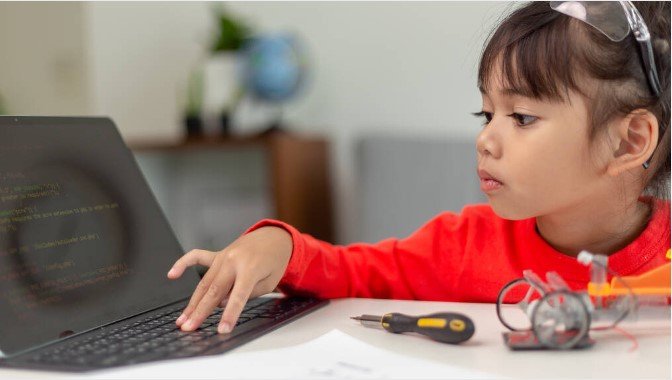Secrets of Block Coding: Is it Easy for Kids?

From creating custom video games to developing sophisticated software, block coding is revolutionizing the way the world works. But is it easy for kids to learn? Unlocking the secrets of block coding can seem like a daunting task, but the truth is, it’s surprisingly approachable. With the right tools and a little bit of guidance, kids can learn to write and understand the fundamentals of block coding in no time. Through a combination of visual and tactile instruction, kids can easily grasp the concepts and apply them to projects they create. Furthermore, they can build on these skills as they grow, using block coding to create more complex software and applications. So, don’t be intimidated – unlocking the secrets of block coding for kids is actually quite achievable.
What is Block Coding?
Block coding is a visual programming language that uses blocks of code to create software applications and projects. It’s a type of coding language that’s easy to learn and understand, making it perfect for kids. Each block of code, or “block”, is like a puzzle piece. When all the pieces are put together, they create a complete program. The code can be written in a variety of languages, such as Python, JavaScript, and Java. Block coding is based on the idea of “drag and drop” coding. Instead of typing out the code, the user drags and drops each block of code into the program. This makes it much easier for kids to understand and follow the code. It also eliminates the need for typing, which can be a difficult concept for kids to grasp.
Benefits of Block Coding for Kids
Block coding provides many benefits for kids. First, it’s a great way to introduce them to the basics of coding. It’s an easy and intuitive way for kids to learn the fundamentals of coding without having to worry about syntax or other complicated programming concepts. By allowing kids to focus on the logic and structure of coding, block coding can help them understand the fundamentals of programming more quickly and easily.
Another benefit of block coding is that it encourages creativity and problem-solving skills. As kids create their own programs, they’ll need to think critically and plan out their steps in order to achieve their desired results. This encourages them to think outside of the box and use their imagination to come up with creative solutions to problems.
Finally, block coding is fun! Kids love the challenge of creating their own programs and solving problems. By making coding fun and engaging, kids are more likely to stay interested and motivated.
What Types of Block Coding are There?
There are many different types of block coding available. Some of the most popular include Scratch, Blockly, and Turtle Graphics. Scratch is a free block coding platform developed by MIT. It’s designed to teach kids the basics of coding while also allowing them to create their own interactive stories, animations, and games. Blockly is a visual programming language designed by Google. It’s perfect for creating apps, games, and websites. Finally, Turtle Graphics is a block coding language designed for teaching kids the basics of programming.
Teaching Block Coding to Kids – Visual and Tactile Instruction
The best way to teach block coding to kids is through a combination of visual and tactile instruction. Visual instruction involves showing kids how to use the blocks of code and how to connect them together. This helps them understand the logic behind the code and gives them a better understanding of the overall structure of the program. Tactile instruction involves letting kids actually use the blocks of code to create their own programs. This allows them to get hands-on experience with the code and gives them the opportunity to experiment and explore. It also helps them develop critical thinking skills as they figure out how to solve problems and create their own programs.
Different Projects and Activities Kids Can Use Block Coding For
Once kids understand the basics of block coding, they can use it to create a variety of projects and activities. For example, they can use it to create their own video games, animations, and even websites. They can also use it to create interactive stories and puzzles. Block coding can also be used to teach kids other concepts, such as math and science. By creating programs that teach these concepts, kids can get a better understanding of how the concepts work and apply them to their own projects.
Common Mistakes to Avoid when Teaching Block Coding to Kids
When teaching coding to kids, it’s important to avoid some common mistakes. First, don’t overwhelm them with too much information at once. It’s better to start with the basics and gradually introduce more complex concepts. It’s also important to be patient with kids and give them time to understand the concepts.
Another mistake to avoid is giving kids too much freedom. It’s important to provide structure and guidance so that kids stay focused on the task at hand and don’t get overwhelmed or distracted. Finally, it’s important to provide feedback and encouragement. This will help keep kids motivated and engaged in the process.
Conclusion
Unlocking the secrets of block coding for kids is actually quite achievable. Through a combination of visual and tactile instruction, kids can easily grasp the concepts and apply them to projects they create. Furthermore, they can build on these skills as they grow, using block coding to create more complex software and applications. With the right tools and a little bit of guidance, kids can learn to write and understand the fundamentals of block coding in no time. So, don’t be intimidated – unlocking the secrets of block coding for kids is actually quite achievable.




